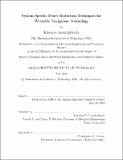| dc.contributor.advisor | Anantha P. Chandrakasan. | en_US |
| dc.contributor.author | Ananthabhotla, Ishwarya | en_US |
| dc.contributor.other | Massachusetts Institute of Technology. Department of Electrical Engineering and Computer Science. | en_US |
| dc.date.accessioned | 2016-12-22T15:15:37Z | |
| dc.date.available | 2016-12-22T15:15:37Z | |
| dc.date.copyright | 2016 | en_US |
| dc.date.issued | 2016 | en_US |
| dc.identifier.uri | http://hdl.handle.net/1721.1/105938 | |
| dc.description | Thesis: M. Eng., Massachusetts Institute of Technology, Department of Electrical Engineering and Computer Science, 2016. | en_US |
| dc.description | This electronic version was submitted by the student author. The certified thesis is available in the Institute Archives and Special Collections. | en_US |
| dc.description | Cataloged from student-submitted PDF version of thesis. | en_US |
| dc.description | Includes bibliographical references (page 73). | en_US |
| dc.description.abstract | As a result of advances in computer vision, mapping, and controls, wearable technology for visually-impaired individuals has become a growing space of research within Assistive Technology. A team at the MIT Energy Ecient Circuits Group has made an important stride forward by presenting a wearable navigation prototype in a fully integrated hardware form factor, but one of biggest barriers to usability of the device is its excessive power consumption. As such, the goal of this work is, broadly, to- (1) Understand the largest sources of power consumption in the initial navigation proto- type system, and expose relevant features for control; (2) Develop a set of algorithms that can capitalize on the motion of a user, the motion of the environment around a user, and the proximity of obstacles within the environment to the user, in order to dynamically tune the exposed parameters to scale power as necessary; and (3) Lay the foundation for the next generation wearable navigation prototype by translating critical software operations and the power scaling algorithms into a hardware architecture capable of working with a smaller and less power intensive depth camera. The first portion of this work focuses on the wearable navigation prototype built around Texas Instrument's OPT9220/9221 Time of Flight chipset. Illumination voltage, frame rate, and integration duty cycle are identied as key control features, and a step rate estimation algorithm, scene statistics algorithm, and frame skipping controller to tune these features are built and tested. The latter half the work focuses on the newer OPT8320 evaluation platform, for which a Bluespec System Verilog implementation of these power algorithms and the point cloud generation operation is presented and tested. Overall, the work demonstrates the critical concept that simple, system specific, fully integrated algorithms can effectively be used to reduce analog power system-wide. | en_US |
| dc.description.statementofresponsibility | by Ishwarya Ananthabhotla. | en_US |
| dc.format.extent | 73 pages | en_US |
| dc.language.iso | eng | en_US |
| dc.publisher | Massachusetts Institute of Technology | en_US |
| dc.rights | M.I.T. theses are protected by copyright. They may be viewed from this source for any purpose, but reproduction or distribution in any format is prohibited without written permission. See provided URL for inquiries about permission. | en_US |
| dc.rights.uri | http://dspace.mit.edu/handle/1721.1/7582 | en_US |
| dc.subject | Electrical Engineering and Computer Science. | en_US |
| dc.title | System specific power reduction techniques for wearable navigation technology | en_US |
| dc.type | Thesis | en_US |
| dc.description.degree | M. Eng. | en_US |
| dc.contributor.department | Massachusetts Institute of Technology. Department of Electrical Engineering and Computer Science | |
| dc.identifier.oclc | 965196711 | en_US |
